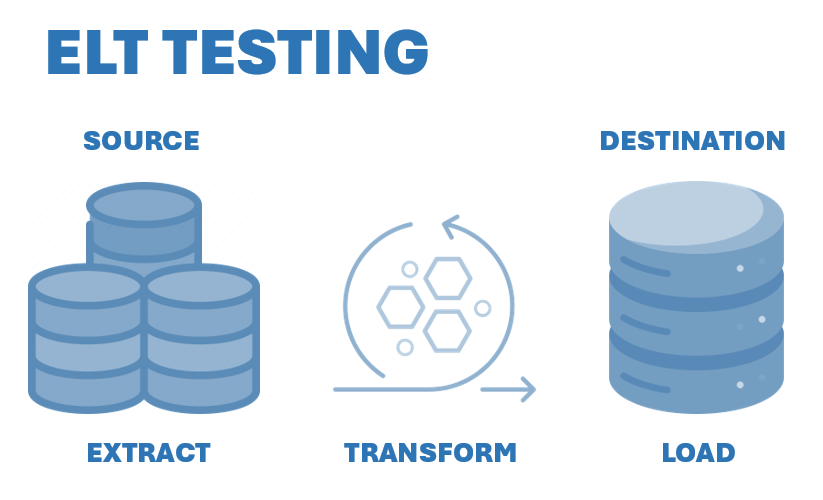Automate ETL testing is essential since it helps our business trust the data and allows us to verify its accuracy. It’s an approach for verifying and contrasting source and destination data to validate the ETL process. Simply put, ETL test automation guarantees the precision and quality of loaded, converted, and removed data.
ETL test automation is necessary for the reason that ETL operations involve a great deal of complexity in terms of data transformation before the data is deposited into a data warehouse. In the case of these kinds of procedures due to an enormous amount of data, manual testing of these procedures is a time-consuming, error-prone, and impracticable operation. Data accuracy may be validated more quickly and effectively thanks to automation testing, which speeds this process.
However, what is the significance of automate ETL testing? This blog post aims to explain ETL test automation, including its types, necessity, and methods for automating ETL testing for data warehouse projects.
Let’s get started!
What is ETL?

ETL (Extract, Transform, Load) testing checks how well data moves from its starting point in source systems. It goes through changes or shapes and then loads onto the destination – often an enormous store of data called a data warehouse or other storage place. The main goal of ETL testing is to make sure the data is correct, complete, and matching during this process.
This checking process is essential to keep the data safe and reliable when using it from the destination system for analysis and business use. Testing ETL is crucial to fix any mistakes, differences, or strange things that might happen when you extract change and add data to ensure the information is okay to use.
Significance in Data Warehouse Projects
ETL testing, extracting, transforming, and loading, is a vital part in data warehouse projects which ensures general reliability and achievement of the warehouse. Let us examine the importance of ETL testing in greater detail:
Assurance of Data Quality
- Data Extraction: Gathering information from several source systems is a part of ETL procedures. ETL testing guarantees accurate data extraction that is free from corruption or loss. It confirms that the extracted data matches the formats and expected values.
- Data Transformation: In this stage, several operations occur on data to meet the requirements for the target data warehouse. The ETL testing helps to validate that these transformations occur rightly, ensuring that the data maintains its integrity and consistency.
- Data Loading: ETL testing validates that the correct and consistent data is loaded into the data warehouse. This phase’s goal is to check data organization, business appropriateness, and suitability for analytical processing.
Business intelligence’s (BI) dependability
To begin with, the purpose of a data warehouse is to ensure that reliable and predictable sources of information exist for corporate intelligence and decision-making.
ETL testing also aims at validating the fusion of business data which is transformed and stored in the data warehouse, to make sure that align with the specifications and business rules.
Detection of Inconsistencies and Abnormalities in the Data
ETL testing facilitates the identification of outliers, inconsistencies, and anomalies in the data. It has to be done to keep the quality of the data and prevent wrong conclusions due to the poor data.
Performance Optimization
A performance aspect is also essential for ETL testing, along with the data accuracy. It tests, detects, and prevents bottle-necks and inefficiencies in the ETL operations, and that the data is processed and loaded into the data warehouse at the right time.
Compliance and Data Governance
ETL testing makes it easier to follow data governance guidelines and meet legal requirements. In order to accomplish this, it takes care to ensure that sensitive data is treated properly and that the data warehouse fulfills internal and industry standards.
Cost Reduction and Efficiency Improvement
Costly errors in the BI and reporting layers are avoided by early identification and resolution of data issues through ETL testing. This lowers expenses and improves the data warehouse’s general effectiveness.
The Need for Automation
Several elements that lead to an overall improvement in the testing process need automation in ETL (Extract, Transform, Load) testing:
Streamlining ETL Testing
By using software tools to run test cases, verify data motions, and inspect transformations, automated ETL testing simplifies the testing procedure. As a result, the entire ETL pipeline is validated more quickly and efficiently.
Automation makes it possible to quickly complete tedious activities like data extraction and validation, giving testers more time to concentrate on more difficult testing tasks like complicated business processes and data integrity.
Enhancing Efficiency
By automating the execution of repetitious test cases, automation significantly increases ETL testing efficiency. Automated tools can run a lot of test cases fast and reliably, giving timely feedback on how well ETL operations are working.
Testing teams can devote more time and resources to addressing challenging scenarios, edge cases, and in-depth research when common tasks are automated. This guarantees a greater quality of data in the data warehouse and results in a more comprehensive testing procedure.
Minimizing Human Errors
The capacity of automation to lower the risk of human mistakes associated with manual testing is one of its main advantages. The possibility of oversight or incorrect interpretation of testing requirements is eliminated by automated ETL testing solutions, which adhere to preset scripts and guidelines.
Automating repetitive, routine tasks reduces the need for human intervention and increases the accuracy of data validation and testing. Maintaining data quality and reliability, particularly in extensive and complex data contexts, depends on this error minimization.
To summarize, integrating automate ETL testing is crucial since it facilitates the testing process, boosts productivity, and lowers the probability of human errors. It makes testing teams’ output more dependable and accurate, eventually boosting the success of data warehouse initiatives as a whole.
How to Automate ETL Testing for Data Warehouse Projects?
The reliability and quality of data transformations and integrations are vital, so ETL (Extract, Transform, Load) testing automation becomes a must for Data Warehouse initiatives. The following is a general guide to automate ETL testing:
Choose the Right Tool
Data comparison tools, ETL testing frameworks, and data visualization tools are three essential areas to take into consideration when selecting tools for your testing requirements: data warehouse architecture and ETL framework.
When comparing datasets, tools like SQL Server Data Tools, Talend Data Quality, and Informatica Data Validation Option can effectively find mistakes and discrepancies.
Frameworks like Pytest-ETL, ETL Validator, and ETL Robot provide an organized and reusable method for ETL testing. These technologies improve efficiency and streamline the testing procedure by automating ETL test cases, scenarios, and workflows.
Consider using Tableau, Power BI, and Qlik Sense together with the ETL procedure for data visualization and analysis. Using these data visualization tools, the users can study and understand the data and make perceptive analyses.
You may create a solid and effective ecosystem for organizing, testing, and visualizing your data across the data warehouse lifecycle by carefully choosing the tools in these areas.
Define the Approach and Scope of the Test.
Determining the scope and approach of your automate ETL testing is crucial to the success of your data warehouse project. It is vital to consider elements like test coverage, test data, and test environment.
Determining which ETL components, data pieces, and transformations require testing and at what frequency is known as test coverage. The test data should reflect real-world situations and scenarios from your data sources and aim.
You can use production data, sample data, or synthetic data, depending on your requirements and limitations. The test environment ought to closely resemble the production environment.
Depending on available resources and security needs, servers, databases, and ETL tools can be deployed on-premises or in the cloud.
Create and Execute the Test Cases.
It is essential to create and execute test cases that address the functional, performance, and security facets of your ETL procedure.
Data quality tests, which confirm the authenticity, consistency, completeness, and accuracy of the data in the source and target systems, are typical forms of ETL test cases.
Data transformation tests evaluate the logic and accuracy of the ETL mappings and transformations.
Finally, data loading tests confirm that the ETL loading procedure is reliable and efficient. A few instances of these are load time, load volume, load error, load concurrency, null value, data type, and business rule checks.
Execute and Monitor the Test Cases.
Using the chosen tools and frameworks, test cases must be executed and monitored. Test runs can be scheduled, test scripts can be triggered, and results can be tracked. There are some best practices to adhere to in order to facilitate this procedure.
For instance, take advantage of test automation solutions that enable you to modify and parameterize your test cases, offer extensive and comprehensible test results and dashboards, link with ETL tools and data sources, and support error handling and debugging capabilities.
Review and Report the Test Results
It is essential to use data visualization and analysis tools for reviewing and reporting test results. Create and distribute test results, graphs, and charts that showcase the most important conclusions and revelations from your ETL testing.
Make use of data visualization tools that allow you to dive down and filter your test data and findings, as well as those that interface with your ETL and test data.
Additionally, look for technologies that facilitate collaboration and interaction and that enable you to export and publish your test findings. Data warehouse initiatives can be made more reliable, efficient, and high-quality by automating ETL testing.
You may easily and confidently automate ETL testing for data warehouse projects by adhering to these best practices and advice.
Conclusion
ETL testing is essential for guaranteeing the reliability and integrity of critical data in data warehousing. automate ETL testing becomes essential as projects become more complicated. It increases cost-effectiveness, improves efficiency, reduces errors, and simplifies procedures.
Selecting the appropriate tools is essential, and LambdaTest is a flexible addition that is particularly useful for accelerating ETL testing processes. LambdaTest’s cloud-based design provides scalability, which helps testing teams make sure that all environments are covered thoroughly.
Effective ETL testing automation is predicated on defining a strategic strategy that includes test coverage, realistic data situations, and a production-mirroring environment. Testing teams can negotiate the complexities of ETL operations with confidence if they follow best practices and integrate automation sparingly.
To put it simply, automating ETL testing is a strategic need rather than merely a necessity. It provides data warehouse projects with the accuracy and dependability needed for well-informed decision-making, guaranteeing long-term success in the constantly changing data environment.





